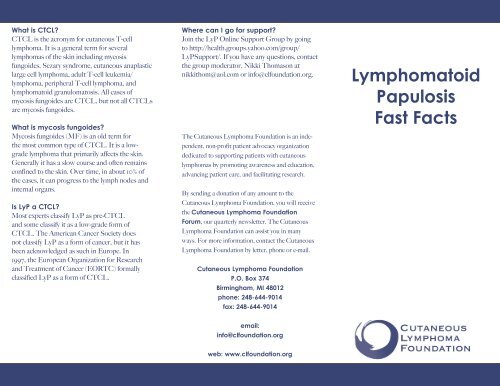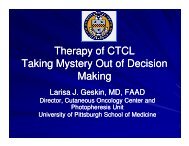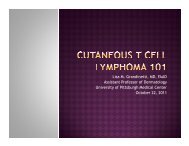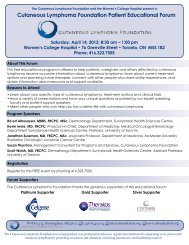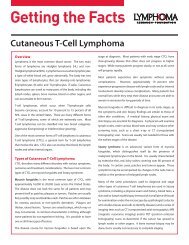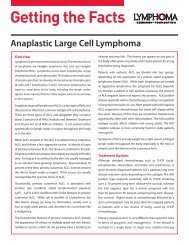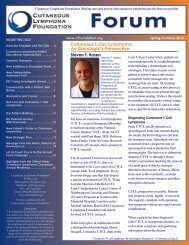Lymphomatoid Papulosis Fast Facts - Cutaneous Lymphoma ...
Lymphomatoid Papulosis Fast Facts - Cutaneous Lymphoma ...
Lymphomatoid Papulosis Fast Facts - Cutaneous Lymphoma ...
You also want an ePaper? Increase the reach of your titles
YUMPU automatically turns print PDFs into web optimized ePapers that Google loves.
What is CTCL?<br />
CTCL is the acronym for cutaneous T-cell<br />
lymphoma. It is a general term for several<br />
lymphomas of the skin including mycosis<br />
fungoides, Sezary syndrome, cutaneous anaplastic<br />
large cell lymphoma, adult T-cell leukemia/<br />
lymphoma, peripheral T-cell lymphoma, and<br />
lymphomatoid granulomatosis. All cases of<br />
mycosis fungoides are CTCL, but not all CTCLs<br />
are mycosis fungoides.<br />
What is mycosis fungoides?<br />
Mycosis fungoides (MF) is an old term for<br />
the most common type of CTCL. It is a lowgrade<br />
lymphoma that primarily affects the skin.<br />
Generally it has a slow course and often remains<br />
confined to the skin. Over time, in about 10% of<br />
the cases, it can progress to the lymph nodes and<br />
internal organs.<br />
Is LyP a CTCL?<br />
Most experts classify LyP as pre-CTCL<br />
and some classify it as a low-grade form of<br />
CTCL. The American Cancer Society does<br />
not classify LyP as a form of cancer, but it has<br />
been acknowledged as such in Europe. In<br />
1997, the European Organization for Research<br />
and Treatment of Cancer (EORTC) formally<br />
classified LyP as a form of CTCL.<br />
Where can I go for support?<br />
Join the LyP Online Support Group by going<br />
to http://health.groups.yahoo.com/group/<br />
LyPSupport/. If you have any questions, contact<br />
the group moderator, Nikki Thomason at<br />
nikkithom@aol.com or info@clfoundation.org.<br />
The <strong>Cutaneous</strong> <strong>Lymphoma</strong> Foundation is an independent,<br />
non-profit patient advocacy organization<br />
dedicated to supporting patients with cutaneous<br />
lymphomas by promoting awareness and education,<br />
advancing patient care, and facilitating research.<br />
By sending a donation of any amount to the<br />
<strong>Cutaneous</strong> <strong>Lymphoma</strong> Foundation, you will receive<br />
the <strong>Cutaneous</strong> <strong>Lymphoma</strong> Foundation<br />
Forum, our quarterly newsletter. The <strong>Cutaneous</strong><br />
<strong>Lymphoma</strong> Foundation can assist you in many<br />
ways. For more information, contact the <strong>Cutaneous</strong><br />
<strong>Lymphoma</strong> Foundation by letter, phone or e-mail.<br />
<strong>Cutaneous</strong> <strong>Lymphoma</strong> Foundation<br />
P.O. Box 374<br />
Birmingham, MI 48012<br />
phone: 248-644-9014<br />
fax: 248-644-9014<br />
<strong><strong>Lymphoma</strong>toid</strong><br />
<strong>Papulosis</strong><br />
<strong>Fast</strong> <strong>Facts</strong><br />
email:<br />
info@clfoundation.org<br />
web: www.clfoundation.org
What is <strong><strong>Lymphoma</strong>toid</strong> <strong>Papulosis</strong>?<br />
<strong><strong>Lymphoma</strong>toid</strong> <strong>Papulosis</strong> (LyP) is a disease<br />
of the immune system that manifests itself in<br />
self-healing papules and nodules (“bumps” and<br />
“spots”) that come and go spontaneously. LyP can<br />
be persistent with recurrent eruptions or it can<br />
disappear for weeks or months at a time before<br />
reactivating.<br />
Who gets LyP and how common is it?<br />
LyP is a one in a million disease – the overall<br />
prevalence rate is estimated at only 1.2 to 1.9 cases<br />
per 1,000,000 population. The onset of LyP can<br />
happen anytime from early childhood to middle<br />
age, and it affects both sexes equally. Only blackskinned<br />
individuals seem to be less affected than<br />
any other racial group.<br />
What does it look like?<br />
LyP is characterized by red-brown bumps and<br />
spots, that may ulcerate and typically heal with<br />
scaling and crusting, and in some instances,<br />
scarring. Large plaques or nodules may occur<br />
but these are rare. Lesions usually heal over 2-3<br />
weeks. The number of lesions can vary from each<br />
eruption and can vary in size and severity with<br />
each onset. Lesions may be asymptomatic or can<br />
be itchy or painful.<br />
Is it contagious or inherited?<br />
LyP is not contagious. There is no supportive<br />
research indicating that this is a genetic or<br />
hereditary disease.<br />
What causes LyP?<br />
Although there is continuing research, at this<br />
time, no single factor has been proven to cause<br />
this disease.<br />
What is the progression of the disease?<br />
In up to 90% of cases, LyP is a persistent or selflimited<br />
disease with no associations with other<br />
immune system diseases and does not affect the<br />
overall health of the patient. In up to 10% of LyP<br />
cases, there is an association with lymphomas,<br />
including progression to Hodgkin’s disease,<br />
cutaneous T-cell lymphoma (mycosis fungoides<br />
(MF)), or anaplastic large cell lymphoma.<br />
In patients with lymphomas, LyP may develop<br />
before, after or at the same time the lymphoma is<br />
diagnosed. Some experts consider LyP to be a low<br />
grade, self-limited form of skin lymphoma.<br />
Is there a cure for LyP?<br />
There is no known cure for LyP, however, there<br />
are therapies that are active in treating lesions.<br />
How is LyP diagnosed?<br />
LyP is diagnosed by a skin biopsy. The<br />
interpretation of the skin biopsy can be<br />
difficult and is best done by an experienced<br />
dermatopathologist. Patients who are diagnosed<br />
with LyP may expect additional studies such as<br />
skin biopsies, blood tests, X-rays and scans to<br />
detect any associated lymphomas.<br />
What are the treatments for LyP?<br />
Treatment depends upon the severity of the<br />
disease. In mild cases, with few lesions, a topical<br />
steroid cream may be used. Steroid creams do not<br />
prevent the development of new lesions but may<br />
be helpful in reducing the lesion symptoms. For<br />
widespread disease with many lesions, PUVA<br />
phototherapy, oral retinoids and low doses of<br />
methotrexate (MTX) can be effective. In patients<br />
with LyP-associated lymphomas, treatment of the<br />
lymphoma will also clear the LyP in most cases.<br />
Support the<br />
<strong>Cutaneous</strong> <strong>Lymphoma</strong> Foundation<br />
Your membership/contribution includes a subscription to<br />
the <strong>Cutaneous</strong> <strong>Lymphoma</strong> Foundation Forum, the only<br />
newsletter that focuses on cutaneous lymphomas. Your<br />
contribution helps promote awareness and education,<br />
advocate for patients and encourage research.<br />
$35 <strong>Cutaneous</strong> <strong>Lymphoma</strong> Foundation membership<br />
Enclosed is my tax-deductible contribution to<br />
the <strong>Cutaneous</strong> <strong>Lymphoma</strong> Foundation of $_______<br />
Credit card donations may be made on-line at<br />
www.clfoundation.org<br />
___________________________________________<br />
name<br />
___________________________________________<br />
address<br />
___________________________________________<br />
___________________________________________<br />
city state zip<br />
Please list my gift anonymously<br />
I wish to make my gift in:<br />
Memory of ______________________________<br />
Honor of ________________________________<br />
Please send notice of my gift to:<br />
(gift amount will not be mentioned)<br />
___________________________________________<br />
name<br />
___________________________________________<br />
address<br />
___________________________________________<br />
city state zip<br />
Please send contribution to:<br />
<strong>Cutaneous</strong> <strong>Lymphoma</strong> Foundation<br />
PO Box 374, Birmingham, MI 48012-0374


